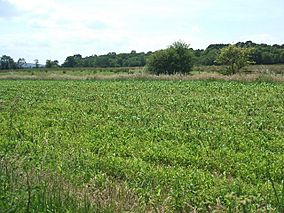Meathop Moss facts for kids
Quick facts for kids Meathop Moss |
|
|---|---|
|
IUCN Category V (Protected Landscape/Seascape)
|
|

The photo is taken outside the nature reserve looking towards the protected area
|
|
| Location | Cumbria, England |
| Area | 82 ha |
Meathop Moss is a special natural area in Cumbria, England. It's a type of wetland called a raised bog, which is like a spongy, wet area that has grown upwards over time. This amazing place is protected as a nature reserve by the Cumbria Wildlife Trust. Meathop Moss is super important because of all the different insects that live there!
In 1965, Meathop Moss was given a special title: a Site of Special Scientific Interest (SSSI). This means it's a place with rare wildlife or geology that needs extra protection. Later, in 2005, it became part of a bigger protected area called the Witherslack Mosses Special Area of Conservation, along with two other bogs nearby.
Contents
What's in a Name?
The name Meathop comes from a nearby place. The word Moss is an old local word that means a bog or a wetland, which perfectly describes this area!
How Meathop Moss Formed
This bog started to grow a very long time ago, after the last Ice Age. It formed on top of an old shingle beach, which is a beach made of small, rounded stones. Over thousands of years, layers of dead plants built up, creating the spongy bog we see today.
Protecting Nature: Charles Rothschild's Story
A Pioneer for Nature Reserves
A long time ago, a man named Charles Rothschild (1877–1923) was very interested in insects. He was an entomologist, which means someone who studies bugs! He realized that Meathop Moss was a really important place for nature, especially for butterflies like the large heath butterfly and the silver-studded blue.
Because of his interest, Meathop Moss became a nature reserve in 1919. At first, the main goal was to stop people from collecting too many butterflies. Rothschild was a very important person in protecting nature in Britain.
The "Rothschild List"
When he was just 22 years old, Rothschild bought another important natural area called Wicken Fen. He gave it to the National Trust, making it one of Britain's very first nature reserves!
He also helped create a list of 284 important natural sites across Britain and Ireland that needed protection. This was called the "Rothschild List," and Meathop Moss was on it! This list was published in 1915 by a group that later became The Wildlife Trusts. Thanks to people like Rothschild, places like Meathop Moss got the protection they needed.
Becoming a Special Scientific Site
In 1965, Meathop Moss was officially named a Site of Special Scientific Interest (SSSI). This recognition helped ensure it would be looked after for its unique plants and animals.
Cumbria Wildlife Trust's Role
The Cumbria Wildlife Trust is a group dedicated to protecting wildlife in the area. They started in the 1960s and eventually took over looking after Meathop Moss. They officially bought the reserve in 1998, with help from the Heritage Lottery Fund. Today, they continue to work hard to keep Meathop Moss a safe home for its amazing insect life and other wildlife.

